Water Supply GRID – Optimiser System (2016)
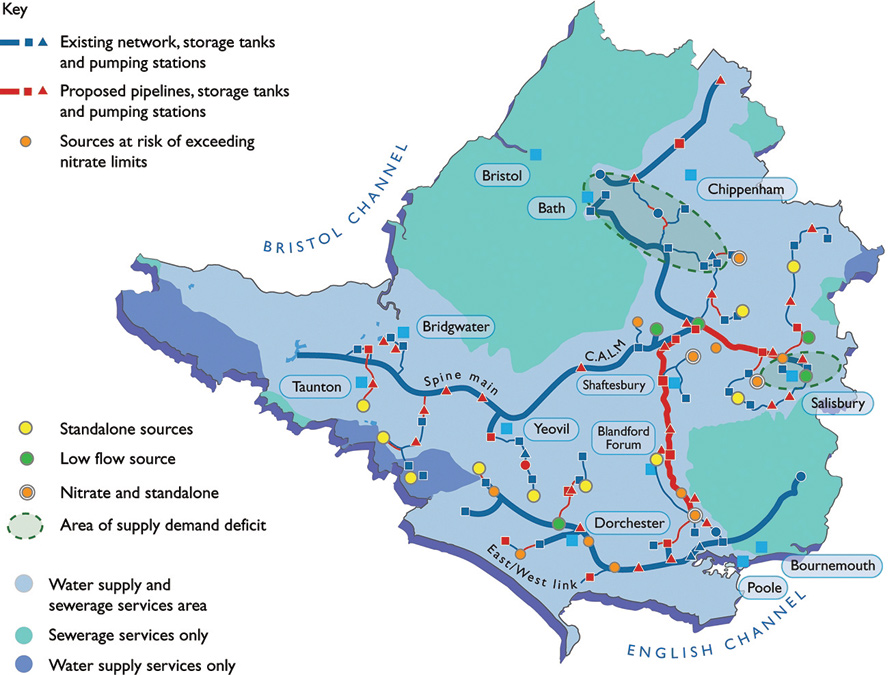
The Integrated GRID - Courtesy of Wessex Water
Since the start of AMP5 in 2010, Wessex Water, in conjunction with Atkins Ltd and Servelec Technologies, has been developing its 74km Integrated Water Supply GRID to improve resilience, and ensure that a reliable supply of water can be maintained after the output from some sources has been reduced to alleviate low river flows. The GRID will greatly improve the flexibility of operation of the supply network, enabling alternative sources to supply demand. The Pump Optimisation System schedules and controls pumps and valves based on demands, flows and reservoir levels. Phase 1 went live in September 2014, and this paper describes the key steps involved to prepare the network and infrastructure and then implement the Optimiser.
Control
Control of the existing system has traditionally been relatively straightforward, typically comprising local automatic pump control based on reservoir profiles.
However, a more sophisticated control system was required for the Water Supply GRID, taking the following factors into account:
- Consider the Water Supply GRID as a whole network, rather than individual sites in isolation.
- Respond to alternative modes of operation, including blending requirements to mitigate high nitrate levels and complicated abstraction licence conditions.
- Maintain assets ready for use (particularly maintaining sweetening and conditioning flows).
- Ensure safe, consistent and optimum operation.
These challenges are depicted in Figure 1 (below).
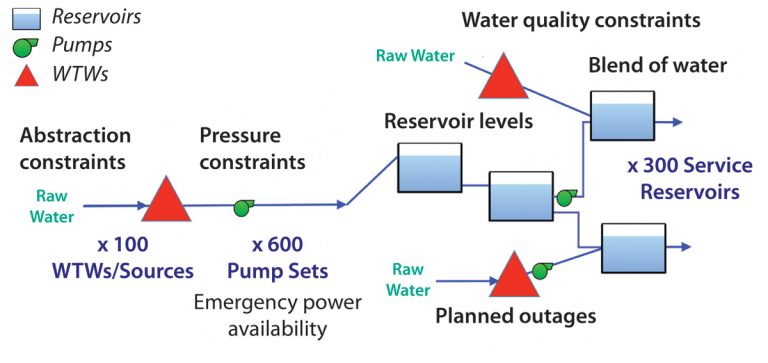
Figure 1
Wessex Water is responding to this challenge by implementing a ‘closed loop’ pump optimisation system (the Optimiser), in order to manage its network effectively.
Planning
Effective planning with careful stakeholder consultation was key to the success of this project and a staged approach as shown in Figure 2. A key feature was the progressive involvement of operations and control room staff.
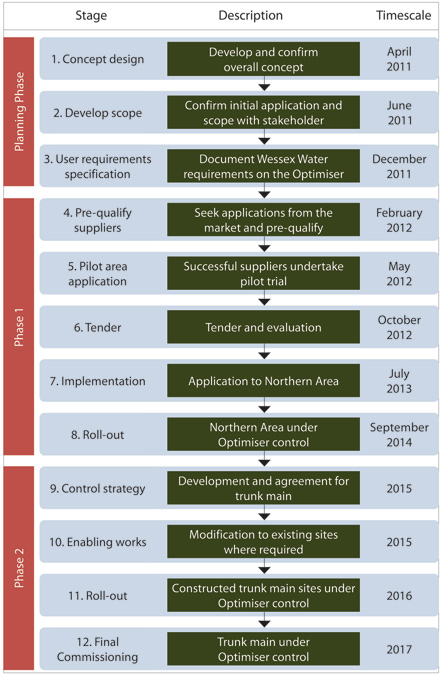
Figure 2
Proprietary online pump optimisation solutions are available which enable energy costs to be minimised. However Wessex Water had particular requirements for the application of such a solution for the Water Supply GRID.
The Water Supply GRID meets a range of needs, in particular enhancing the security of supply by enabling water to be transferred from sources with spare capacity in the south of Wessex Water’s region to the north. The north is currently supplied by a number of sources where licensed abstractions will be reduced to alleviate low river flows.
A key part of the Water Supply GRID is a 74km trunk main which transfers water to this area from the south. The GRID also provides an alternative supply to systems currently served by a single, isolated source, and will allow blending of water from sources with potential for high levels of nitrate.
The Water Supply GRID provides an integrated and flexible supply network. It will operate under a number of modes of operation, rather than one single, consistent mode of operation.
Furthermore, assets need to be kept ready for use when required, which means that sweetening and conditioning flow regimes are needed to maintain water quality. Enhancing resilience was the key consideration for the Optimiser rather than operational cost savings.
In order to establish Wessex Water’s particular requirements for the Optimiser, Atkins Ltd arranged a series of stakeholder workshops. Operations staff were key participants, but Water Resources planning, IT and Water Quality staff were also consulted.
Prior to the workshops, the team consulted suppliers and other users of optimising solutions to gain a good understanding of the scope of technologies available. This enabled stakeholders’ expectations to be managed appropriately.
The output from these workshops was the production of a comprehensive User Requirements Specification (URS). Of equal importance was the “buy-in” for the project across the wide range of Wessex Water stakeholders. The aim was to develop a URS that pushed the supply chain and secured innovation:
- Proven, available technologies – 60-70%
- Necessitated bespoke supplier developments – 20%
- Created a push-back from suppliers (unrealistic requirements) – 10%
A key part of the evaluation of potential suppliers was a closed loop pilot trial undertaken in the spring of 2012. The area selected for the trial was a very simple part of the network. Prior to the trial we reviewed the network on which the Optimiser was going to be initially deployed, and identified enabling works required. This involved reviewing the quality of data available (including pump curves and measured flows), the facilities for remote control (including central hardware) as well as the security of existing telemetry assets.
As a result pumps were tested, telemetry was replaced and amended, and new assets such as float switches were installed in the reservoir under trial, and manually tested to ensure that remote control would be overridden in the event of violation of reservoir limits. The trial started once the enabling works were completed and a comprehensive risk assessment had been undertaken. Each potential supplier’s trial was successful, which further increased the confidence of operators in the remote closed loop optimisation approach being proposed.
At this point Servelec Technologies was appointed as the preferred supplier of the Optimiser software.
Implementation to Phase 1 area
The Optimiser is implemented using the Servelec Technologies software MISER which takes live information such as flows and reservoir levels from telemetry, forecasts demand over the following few days and controls the supply network automatically night and day, to meet customer demands, abstraction licences and other constraints at minimum cost.
Implementation involved modelling of the Phase 1 area (Warminster to Bath) and a number of software enhancements to meet Wessex Water’s specific requirements.
Model configuration
The model schematic was constructed using the MISER Client interface with configuration data provided by Wessex Water, including:
- Abstraction licences, monthly planning limits, river flows, spring yields.
- Chemical costs, maximum rates of flow change.
- Pump performance, electricity tariffs.
- Pump switching/rotation constraints, operating rules.
- Maximum/minimum flows/pressures, sweetening flows.
- Service reservoir capacities, operating and target levels.
- Demand equations, based around the availability of meter signals.
Data sources included asset databases, operator knowledge, pump test results and energy team data. Following configuration, the model was successfully verified against historical telemetry flows and level data.
The model was subsequently optimised, unconstrained by historical operation, and results reviewed by Wessex Water. An iterative process was adopted of incorporating feedback and re-running the model across a range of demand and outage scenarios.
Telemetry configuration
MISER integrates with the Servelec Scope-X telemetry system. Live telemetry data are automatically used by MISER to produce optimal control instructions which are then implemented via Scope-X.
Telemetry data are validated before use, replaced if necessary (by using alternative meters) and processed to produce historical and predicted reservoir volumes, flows (to monitor daily licence usage) and demand values.
Control room
Every 30 minutes, MISER optimises the network and provides control instructions to Scope-X for immediate implementation. In addition, the latest optimal schedule for the next 72 hours is provided to the user for forward guidance if needed.
These results and the current state of the network, updated in real-time, are monitored via the MISER Control Room interface. This interface is in the form of web pages, providing familiar Internet Explorer functionality, which can be accessed from any workstation within the Wessex Water secure environment.
On the Schedule Editor screen users review and approve schedules and specify changes to current and future operation such as pump outages, pump must-runs, valve flows and reservoir operating limits.
Changes are incorporated into the MISER model and applied at the next optimisation (either scheduled or ad hoc). Telemetry alarms, such as poor water quality, Triad warnings and pump outages, are used directly by MISER via digital signals to constrain the model.
Similarly, MISER issues alarms (on Scope-X) if a problem is identified in the optimisation, such as a reservoir lower limit being forecast to be broken, giving users early warning of potential supply issues.
In this first phase of implementation, the model build was carried out by Servelec Technologies. Wessex Water has taken on the model maintenance and further model construction for the Phase 2 (Trunk Main) model, taking full ownership and control of the Optimiser system.
Training
There will be different levels of users interfacing with the Optimiser. The user access permissions range from being able to view the current state of assets, apply planned maintenance activities, and administer the databases behind the Optimiser through to adding assets to the MISER model.
Servelec Technologies provided initial training to the different users of the Optimiser to enable them to perform the tasks required. Further training has been provided by Wessex Water’s Supply Optimisation Team as sites were brought on-line, to educate the users in how to perform their tasks within the live Wessex Water environment, rather than a training environment.
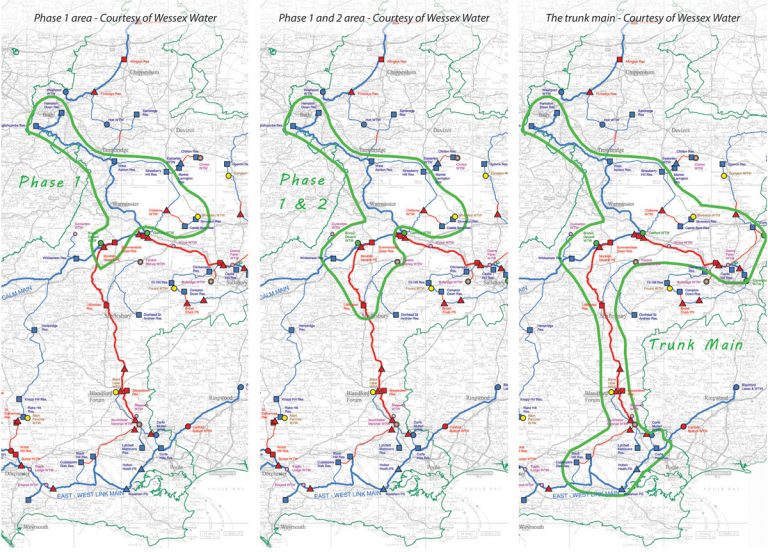
Figure 3
The Optimiser in use: Helping manage an operational outage
To satisfy the demand on a service reservoir within part of the area under Optimiser control a total average daily inflow of 18Ml/d is supplied from three water sources.
Due to a borehole failure at one works and subsequent shutdown at another, the total supply available to this reservoir dropped to around 9Ml/d (50% of that required). This reduction presented a significant risk to supplies to several thousand customers.
Action was taken by the Supply Operation Controllers in the Regional Control Room to alert network and production teams to reduce the demand out of the reservoir. This would allow more time to replace the failed borehole pump and to flush the shutdown works to waste before putting it back into service.
The failed borehole pump was replaced under difficult working conditions. At the same time the Optimiser was used very effectively throughout to recalculate and predict storage levels in the reservoir as the various system adjustments were made.
This gave two clear benefits, being able to extend the much reduced available supply and also to provide a clear understanding of the time available to complete repairs.
Phase 2 extension of the Optimiser to the 74km trunk main
The north-western section of the trunk main was commissioned in December 2015. The commissioning included extending the Optimiser to control assets in this section in early 2016. This £30m system connects, via a new 20km trunk main, a new reservoir at Shaftesbury with a new pumping station and reservoir in the Deverills, which in turn is connected to the existing water supply system in the Warminster area.
The new trunk main, known as the Deverills Link, incorporates dedicated supply reservoirs that transfer across to the existing distribution supply reservoirs. This allows far greater flexibility in moving water within the network. The trunk main system transfers water between critical nodes without impacting on storage held in the local distribution system.
The Deverills Link was designed to be operated as a completely standalone section as it was recognised it would be a number of years before the whole system was completed.
The main link between Shaftesbury and the Deverills has been designed to be bi-directional with the facility to booster chlorinate in either direction.
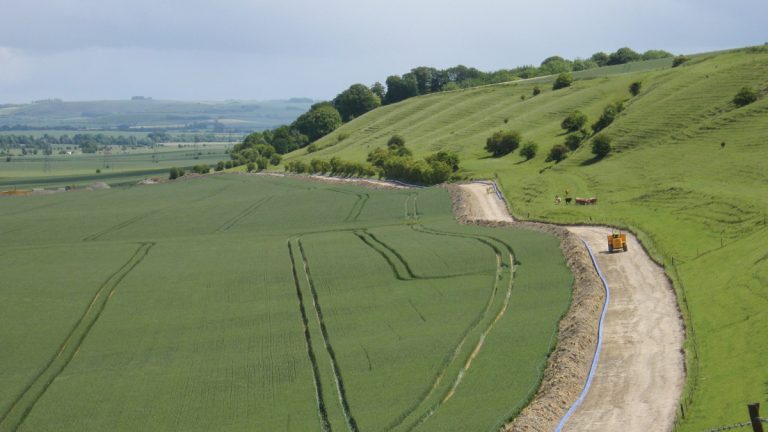
Construction of recent water supply pipeline – Courtesy of Wessex Water
Next steps
As the remainder of the trunk main system is completed between now and March 2018 the Optimiser will be incorporated as part of the control system. This includes the Salisbury areas where the Optimiser will have to manage some very complex abstraction licence conditions whilst helping ensure effective nitrate blending at the same time.
Summary of benefits from using the Optimiser
The Optimiser has introduced a radically different way of controlling water supply sources and networks.
It allows an holistic view to be taken over the supply network and over the days ahead – rather than decisions being based on only the current water level in the adjacent reservoir. This gives many benefits, including:
- Improved security of supply and contingency planning.
- Efficient transfer of flows in a complex supply system.
- Efficient management of assets in a complex transfer and distribution system.
- Savings made in avoiding Triads and Duos periods.
- Optimal outage planning.
- Optimal blending ratios for nitrate sources.
- Reduced call outs out- of- hours as forecast provides more confidence in networks flexibility.
Conclusion
The successful implementation of a closed loop pump scheduling system has been a challenge for Wessex Water. It has been a unique project that involved various disciplines within the company working together to provide their expertise for a common goal.
This more intuitive way of controlling our supply network has involved considerable investment and infrastructure improvements, as well as a fundamental change in control philosophy from local to central control. Furthermore, the business transformation programme has been key to successfully delivering the project to Operations who will be responsible for the day-to-day running of the Optimiser.
Despite being a closed loop system, it is important to note that the Optimiser requires manual input on a daily basis, to not only act as an auditory review, but to adjust the constraints to gain maximum benefit from the network and its assets. In this way, we continue to push the boundaries of our network within given constraints and may well extend the Optimiser area in future.



